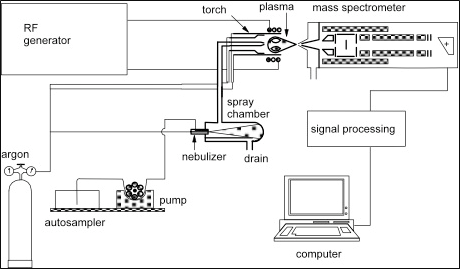Author: Parimal Ramesh Udgave
What is ICP-MS?
Inductively Coupled Plasma Mass Spectrometry (ICP-MS) is a sort of mass spectrometry which is equipped for recognizing metals and a few non-metals at fixations as low as one section in 1015 (section per quadrillion, ppq) on non-meddled low-foundation isotopes. This is accomplished by ionizing the sample with inductively coupled plasma and afterward utilizing a mass spectrometer to particular and evaluates those particles.
Contrasted with atomic absorption spectroscopy, ICP-MS has more noteworthy speed, accuracy, and affectability. In any case, contrasted and different kinds of mass spectrometry, for example, Thermal Ionization Mass Spectrometry (TIMS) and Glow Discharge Mass Spectrometry (GD-MS).
The assortment of utilizations surpasses that of Inductively Coupled Plasma Atomic Emission Spectroscopy (ICP-AES) and incorporates isotopic speciation.
Components
- Inductively coupled plasma: Inductively coupled plasma is plasma that is stimulated (ionized) by inductively warming the gas with an electromagnetic curl, and contains an adequate convergence of particles and electrons to make the gas electrically conductive. Inductively coupled plasma (ICP) for spectrometry is supported in a light that comprises of three concentric tubes, normally made of quartz. This can be called as torch. End of this torch is based inside the induction coil which is supplied with electric current. A stream of argon gas (13 to 18 L/minute) is presented between the two furthest containers of the light and an electric start is connected for a brief span to bring free electrons into the gas stream. These electrons connect with the radio-frequency magnetic field of the induction coil and are quickened first one way, at that point alternate, as the field changes at high recurrence (generally 27.12 million cycles /second). A nebuliser can be utilized for fluid examples, trailed by a spray chamber to evacuate large droplets, or a desolvating nebuliser can be utilized to dissipate a large portion of the dissolvable before it achieves the light. For Solid samples, Laser Ablation can be used.
- Mass Spectrometry: For coupling to mass spectrometry, the particles from the plasma are removed through a progression of cones into a mass spectrometer, normally a quadrupole. The particles are isolated based on their mass-to-charge proportion and an identifier gets a particle flag relative to the focus. The calibration of given sample can be resolved through adjustment with guaranteed reference material, for example, single or multi-component reference measures. ICP-MS additionally fits quantitative conclusions through isotope weakening, a solitary point technique in light of an isotopically enriched standard.

Components of ICP-MS
Applications:
- ICP-MS is mostly used in the field of Toxicology.
- ICP-MS is suitable for metal and heavy metal assays and finding out traces of metals in plants or animal tissues.
- We can use it for water purity tests.
- Environmental studies eg. Metal contents in sea water or aquatic plants and animals.
- It can be also used in geochemistry and soil chemistry to study radioactive dating and soil toxicity assays.
- It can replace Flow cytometry.
- Detection of inorganic impurities in pharmaceutical drugs.
- Speciation studies of different isotopes of a metal or compounds.
- Quantification of proteins and other biomolecules.
- As compared to atomic absorption spectroscopy or optical emission spectroscopy, which can only measure a single element at a time, ICP-MS has the ability to examine for all components at the same time. This permits rapid analysis.
About Author / Additional Info:
I have completed MSc Biotechnology at Sheffield Hallam University, GB.